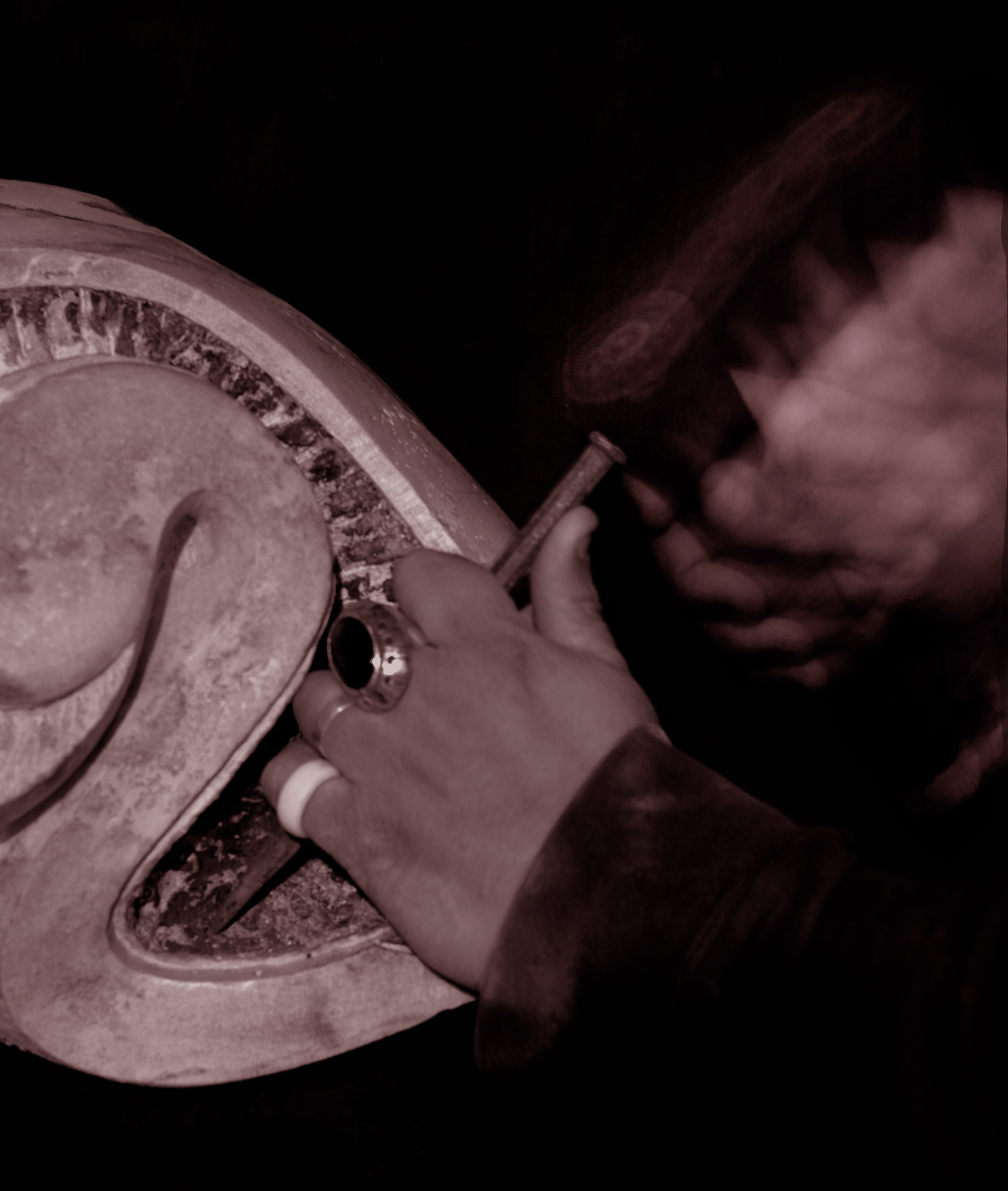Statement:
My aesthetic and philosophical explorations are shaped by the landscape of my atavistic memories. For the past 17 years, I have held a residency at the Schomburg Center for Research in Black Culture in Harlem, New York. Having direct access to the world’s largest collection of manuscripts and artifacts from the African world has profoundly impacted my practice, facilitating a richer understanding of the revelatory power of Black aesthetic syncretism. A disciple of contemporary Shona and Makonde sculpting techniques, I employ their interpretation of direct carving with Afro-diasporic sensibilities. I see my sculptures, paintings, and photographs as votive offerings in the cosmic temple of the Black collective unconscious. Thematically, my work lives in the land of myth and enchantment, honoring the divine archetypes of a new Negro pantheon.
My most visceral and focused statements are achieved through improvisation. Improvisation allows me to snatch an image at birth, creating a balance between imposing and communicating with the natural life force resonating from within my materials. Ultimately, what will always excite me is the opportunity to deconstruct/reconstruct inner visions and impulses unique to Black culture…the call and response/the space within space.
Bio:
New York artist M. Scott Johnson (American b. 1968) has carved out a space as one of the most adept sculptors of his generation. The nexus of his practice revives the intuitive process of Direct Carving in Black American expression while investigating the culture's mythologies, ritual, and post-colonial realities. Deeply impacted by his 19-year teaching artist residency at the Schomburg Center for Research in Black Culture in Harlem, NY, Johnson has developed a unique multi-historical vision of contemporary Negro aesthetics. As an undergraduate student, Johnson was intellectually mentored by acclaimed Black anthropologist, Dr. Warren Perry. Perry was central in his recognition of anthropology as a conduit to map and reclaim dormant visual aesthetics. The essay Characteristics of Negro Expression (1934) by cultural anthropologist, Zora Neal Hurston, provided Johnson his Rosetta Stone.
While a member of the organization Operation Crossroads Africa, Johnson’s formal education as a sculptor began in Bulawayo, Zimbabwe in 1994. At that time, the country was exhibiting some of the most soulful contemporary stone sculpture in the world. Deeply drawn to the work, Scott explored traditional and contemporary direct sculpting practices guided by local artists. Johnson’s greatest opportunity came when he was granted an apprenticeship (1996-1999) with internationally recognized sculptor and national hero, Nicholas Mukomberanwa (1940 - 2002). In Mukomberanwa’s studio, Johnson thrived, digesting more than just technique, he battled to decolonize the landscape of his imagination. Driven to expand the harmonics of rhythm and pattern in African American material culture, his work is birthed through a combination of improvisation and atavistic memory. Born and raised in Inkster, MI, M. Scott came of age during the blossoming of Techno music in Detroit, his sculpture is a tangible reflection of those Afrofuturist sonic metaphysics.
M. Scott Johnson's works are included in the permanent collections of Hampton University Museum, VA.; Kenkelaba House NY; The Schomburg Center for Research in Black Culture NY; and the U.S. Embassy in Oslo, Norway. His work has been exhibited at Columbia University NY; Embassy of the Republic of Ghana D.C.; Galerie Myrtis MD; Harvard University; Hampton University Museum VA; Kenkeleba House NY; Fabric Projects Gallery, Los Angeles; Wilber Jennings Gallery NY; TransAfrica Forum; National Gallery of Zimbabwe; Grey Art Gallery at New York University; Museum of Contemporary Diasporan Art Brooklyn NY; Rush Arts Gallery, NY; The Schomburg Center for Research in Black Culture NY; New York Botanical Gardens; The Charles H. Wright Museum of African American History MI; United Talent Agency Artspace Los Angeles; U.S. Embassy in Oslo Norway;The 13th Havana Biennale, Galeria Carmen Montilla and the 59th Venice Biennale Personal Structures: Time, Space and Existence at Palazzo Bembo. Johnson’s public work with Black youth have been installed throughout New York City including the Williamsburg Historical Society, Bronx Historical Society, Cork Gallery in Lincoln Center, and The Town Hall off-Broadway.





